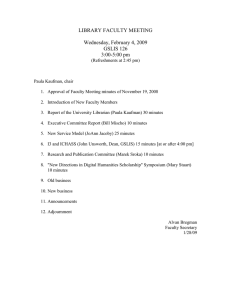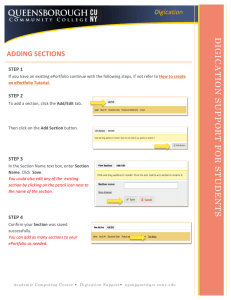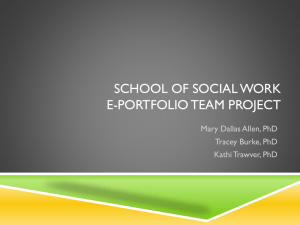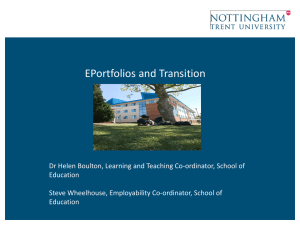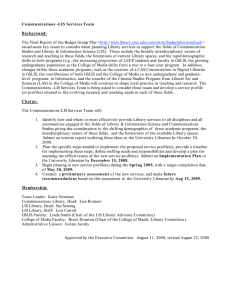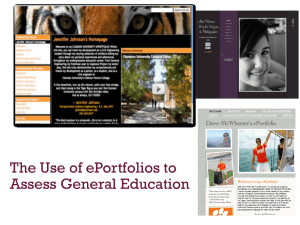Making Connections Seminar: ePortfolio Queens College ePortfolio Group
advertisement
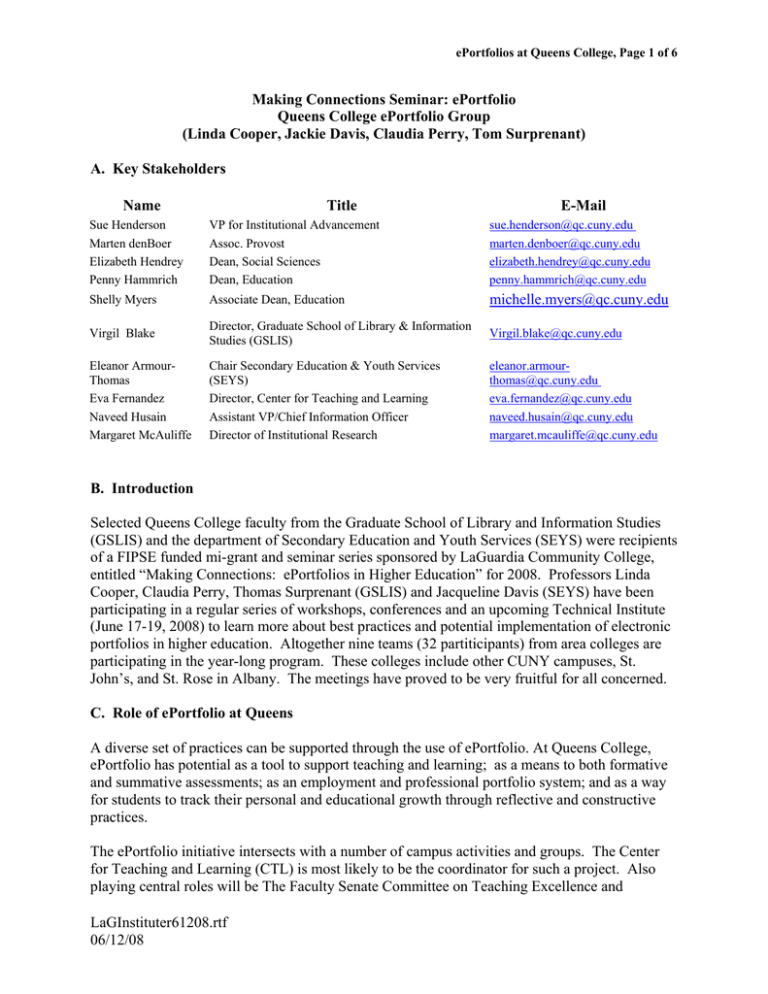
ePortfolios at Queens College, Page 1 of 6 Making Connections Seminar: ePortfolio Queens College ePortfolio Group (Linda Cooper, Jackie Davis, Claudia Perry, Tom Surprenant) A. Key Stakeholders Name Title E-Mail Sue Henderson Marten denBoer Elizabeth Hendrey Penny Hammrich VP for Institutional Advancement Assoc. Provost Dean, Social Sciences Dean, Education sue.henderson@qc.cuny.edu marten.denboer@qc.cuny.edu elizabeth.hendrey@qc.cuny.edu penny.hammrich@qc.cuny.edu Shelly Myers Associate Dean, Education michelle.myers@qc.cuny.edu Virgil Blake Director, Graduate School of Library & Information Studies (GSLIS) Virgil.blake@qc.cuny.edu Eleanor ArmourThomas Eva Fernandez Naveed Husain Margaret McAuliffe Chair Secondary Education & Youth Services (SEYS) Director, Center for Teaching and Learning Assistant VP/Chief Information Officer Director of Institutional Research eleanor.armourthomas@qc.cuny.edu eva.fernandez@qc.cuny.edu naveed.husain@qc.cuny.edu margaret.mcauliffe@qc.cuny.edu B. Introduction Selected Queens College faculty from the Graduate School of Library and Information Studies (GSLIS) and the department of Secondary Education and Youth Services (SEYS) were recipients of a FIPSE funded mi-grant and seminar series sponsored by LaGuardia Community College, entitled “Making Connections: ePortfolios in Higher Education” for 2008. Professors Linda Cooper, Claudia Perry, Thomas Surprenant (GSLIS) and Jacqueline Davis (SEYS) have been participating in a regular series of workshops, conferences and an upcoming Technical Institute (June 17-19, 2008) to learn more about best practices and potential implementation of electronic portfolios in higher education. Altogether nine teams (32 partiticipants) from area colleges are participating in the year-long program. These colleges include other CUNY campuses, St. John’s, and St. Rose in Albany. The meetings have proved to be very fruitful for all concerned. C. Role of ePortfolio at Queens A diverse set of practices can be supported through the use of ePortfolio. At Queens College, ePortfolio has potential as a tool to support teaching and learning; as a means to both formative and summative assessments; as an employment and professional portfolio system; and as a way for students to track their personal and educational growth through reflective and constructive practices. The ePortfolio initiative intersects with a number of campus activities and groups. The Center for Teaching and Learning (CTL) is most likely to be the coordinator for such a project. Also playing central roles will be The Faculty Senate Committee on Teaching Excellence and LaGInstituter61208.rtf 06/12/08 ePortfolios at Queens College, Page 2 of 6 Evaluation, the Undergraduate Curriculum Committee, the Graduate Curriculum Committee, participating departmental curriculum committees, other departmental and/or college-wide assessment and evaluation committees (primarily Middle States and Strategic Planning) and the Office of Converging Technologies (OCT). Given the need for extensive digital storage and digital access, ongoing support from OCT will be crucial. This project can only succeed with the active financial and moral support of the President as well as his Cabinet, the Provost, the College’s Deans and participating Department Chairs. D. Background and Goals The overarching goal of the Queens College ePortfolio group is to introduce the full concept of the ePortfolio to our college community. We plan to have a pilot ePortfolio program at the GSLIS and the department of SEYS in the Fall of 2008. The pilot project will serve as both a test bed and an exemplar for the College in terms of support for teaching, learning and reflection. A secondary goal is to evaluate the ePortfolio as an assessment tool. E. Projects Graduate School of Library & Information Studies (GSLIS) Assessment The GSLIS Committee on Planning and Assessment is making preliminary plans for program assessment using the School Goals and Objectives, in preparation for an accreditation visit during the 2011 Academic Year. The Committee has developed a pilot project that will establish basic rubrics for a range of S, chool goals and objectives. Our initial proposal involved five faculty on the Committee (including the GSLIS ePortfolio group), who submitted student work in five distinct courses. Initially, we expected to develop assessment rubrics for each course and examine relevant objectives appropriate to the particular assignments identified for review. On further reflection, and in consultation with Institutional Research Director Meg McAuliffe, we have made minor modifications in our plan of action. Rather than examine a mix of advanced electives and core courses, it seems more feasible to focus on courses required of all students in the general program, as well as several required courses in the Library Media Specialist (LMS) Program, which leads to NYS teacher certification in that area. The latter are especially appropriate given NCATE requirements for student portfolios, and similarities between program needs and requirements in the Division of Education and our School Library Media Program. Information regarding the achievement of LMS teacher education students is required in our regular reports to Queens College TEAMS (Teacher Education Assessment Management System). An assignment in each of three required courses has been paired with two of the most relevant GSLIS objectives. Due to overlap, five objectives will be examined in the revised pilot. We are in the process of developing a rubric for each of the five objectives based on the characteristics of the objective under examination (as recommended in the Assessment Workshop at the Making LaGInstituter61208.rtf 06/12/08 ePortfolios at Queens College, Page 3 of 6 Connections Conference in April). Our plan is to develop a set of rubrics that will assess the relationship of student competencies as reflected in specific assignments to program objectives, thus serving as a tool for program assessment. This set of rubrics should be applicable to many courses since satisfaction of program objectives is an overarching imperative for the GSLIS curriculum. The rubrics then will be used to evaluate how well the student work reflects program objectives at various level of competence. Professors Cooper and Perry will serve as primary evaluators, with Professor Surprenant acting as the third evaluator in case of rating disparities. Further finetuning of the rubrics and the process will continue over time. Results will be provided to the faculty at our annual retreat in the Fall of 2008. The courses and assignments for this first iteration will include the following: • • • GSLIS 700 (The Technology of Information): Web Site Assignment GSLIS 702 (Information Sources and Services: General): User Reference Assignment GSLIS 763 (formerly Nonbook Materials: Sources and Service; now Instructional Technologies for Information Literacy): Curriculum Unit Assignment A similar approach is planned for Fall 2009, using the following required core courses: • • GSLIS 701 (Fundamentals of Library and Information Studies) GSLIS 703 (Introduction to Technical Services) Course & Student ePortfolios In the Fall 2008 semester a related initiative will be conducted using sections of GSLIS 700, GSLIS 706 (Advanced Technological Concepts), and GSLIS 761 (Organization and Management: Media Centers). In these courses students will be creating ePortfolios that include self-assessments, samples of class work and resumes. To create ePortfolio pages (coded as HTML) students will use Sea Monkey Composer in GSLIS 700 and Dreamweaver in 706. At the beginning of the Spring 2009 semester the Committee on Planning and Assessment will evaluate the results of this pilot and draw up plans for integrating ePortfolios into the GSLIS curriculum. Introducing the ePortfolio to GSLIS students The School has set aside time during the semester for students to attend various presentations related to both the profession and the curriculum (designated the Curriculum Space). The Committee on Planning and Assessment will have at least one ninety minute presentation during Fall 2008, that introduces the idea of the ePortfolio as a route to professional and selfdevelopment. LaGInstituter61208.rtf 06/12/08 ePortfolios at Queens College, Page 4 of 6 Secondary Education and Youth Services (SEYS) Within the SEYS Department in the Division of Education (foreign language education program) the portfolio is used as an NCATE program assessment and as a required component of the initial certification programs at the undergraduate and graduate level. It also is a component of the graduate professional program. The portfolios are both course requirements and exit requirements for program completion. The department has experimented with paper portfolios, ePortfolios using a paid service, and digital portfolios submitted on CDs or transmitted digitally. All undergraduate minors in the program and all graduate candidates admitted since 2004 are required to create a portfolio as an exit requirement. Graduate candidates who were admitted before 2004 are required to complete portfolios as course requirements, as well. GSLIS & SEYS Cooperation with the Center for Teaching and Learning We have been in regular contact with the Center for Teaching and Learning, which will facilitate some of the initiatives we propose in this document, and which will serve as a co-sponsor of our activities, along with the Academic Senate Committee on Teaching Excellence and Evaluation, and with other units in the Queens College administration (President's office, Provost's office, Office of Converging Technologies). With the administrative support of the Center for Teaching and Learning, we will organize campus-wide workshops for faculty and selected students in the Spring 2009 semester, and will continue regular communication with other members of the key stakeholders listed on page 1 of this document. Accomplishments to Date - GSLIS 9 Participating in a community of practice through the Making Connections project at LaGuardia Community College. This has resulted in a much deeper understanding of ePortfolio and its role in higher education and professional development 9 Planning a pilot project in preparation for a full program assessment, which will be conducted in anticipation of the scheduled re-accreditation visit in 2011 9 Developing rubrics to assess the relationship of GSLIS program objectives to student competencies as reflected in specific assignments 9 Reorganizing a GSLIS 700 assignment (web page creation) into a pilot ePortfolio activity 9 Creating a new course (Advanced Technological Concepts) that is centered on the creation of ePortfolios 9 Reorganizing a selected SMLS course (761: Organization and Management: Media Centers) to include ePortfolio components 9 Preliminary conversations with the Center on Teaching and Learning for a workshop, or series of workshops, on ePortfolios for campus faculty and selected students Accomplishments to Date - SEYS 9 ePortfolios are currently in place and under refinement 9 ePortfolio implementation is under review for possible refinement LaGInstituter61208.rtf 06/12/08 ePortfolios at Queens College, Page 5 of 6 Next Steps – GSLIS 9 9 9 9 9 9 9 9 9 9 Begin involving students in the process of planning and implementation Complete the rubrics for the pilot assessment project Evaluate student work using the rubrics developed Evaluate and revise the rubrics Extend the pilot assessment project to two additional core courses (701, 703) Report results to the GSLIS faculty, students, Making Connections colleagues and the QC community Create an ePortfolio template for use by students Create presentation on ePortfolios for GSLIS students Create staged plan for the incorporation of the ePortfolio into selected components of the GSLIS curriculum Evaluate possible platforms for Queens to consider in a large scale ePortfolio implementation in close cooperation with the Office of Converging Technologies (OCT), LaGuardia Community College, and other CUNY campuses Next Steps – SEYS 9 9 9 9 Share information on ePortfolios with other units within the Division of Education See if other units are interested in using ePortfolios Adapt the existing ePorfolio as needed for wider use Hold more detailed, follow-up consultations with interested parties; adapt the ePortfolio to their specific needs 9 Use the information sharing and consultations to extend participation and refine planning for the future Next Steps – CTL, GSLIS , SEYS and other Key Campus Stakeholders 9 Create a funding proposal for ePortfolios at Queens 9 Work with the Center on Teaching and Learning in conjunction with the Office of Converging Technologies (OCT) and others to introduce ePortfolios on campus 9 Plan and implement a workshop, or workshops, that will begin to involve faculty from other disciplines on campus 9 Recruit students that will be trained as ePortfolio mentors and develop a training program for them 9 Identify at least one additional department that will be willing to begin to incorporate the ePortfolio into their program 9 Develop a training program for the selected department(s) 9 With the Office of Converging Technologies (OCT), create a plan for the incorporation of software or an ePortfolio platform to support large scale implementation. Any such plan will have to have a full set of administrative policies, rules and regulations and involve key decision makers in the staged implementation of ePortfolios at Queens LaGInstituter61208.rtf 06/12/08 ePortfolios at Queens College, Page 6 of 6 9 Assist the Center for Teaching and Learning, faculty, students and key stakeholders in identifying major issues, planning needs, and other challenges relating to the implementation of ePortfolios at Queens LaGInstituter61208.rtf 06/12/08
